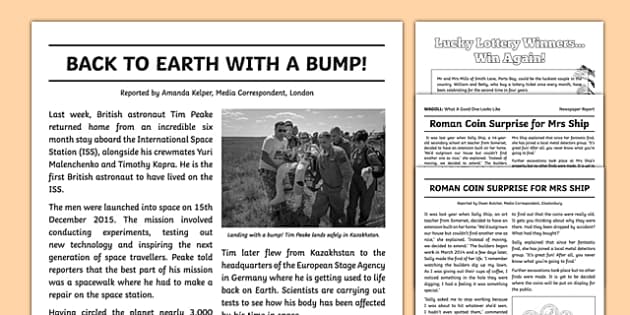The 20-Second Trick For News Articles
The 20-Second Trick For News Articles
Blog Article
The Greatest Guide To News Articles
Table of Contents4 Easy Facts About News Articles DescribedNews Articles Can Be Fun For EveryoneThe Main Principles Of News Articles Getting The News Articles To WorkNews Articles Things To Know Before You Get This
Great knowledge of different topics gives trainees a competitive side over their peers. Also though electronic and social networks are conveniently easily accessible, we should not neglect how crucial it is to read the newspapers. Moms and dads must attempt and instill the habit of checking out a paper as an everyday routine to continue the heritage of the revered print tool.News stories likewise have at the very least one of the adhering to important features relative to the intended target market: closeness, importance, timeliness, human passion, curiosity, or consequence. The related term journalese is sometimes made use of, typically pejoratively, to refer to news-style writing. Another is headlinese. Newspapers typically comply with an expository writing style.
Within these restrictions, information stories additionally aim to be comprehensive. Various other factors are involved, some stylistic and some acquired from the media type. Among the larger and much more revered papers, fairness and balance is a major element in offering info. Commentary is typically constrained to a different area, though each paper may have a various total angle.
Newspapers with a worldwide audience, for example, tend to make use of a more official design of composing. News Articles.; usual design overviews include the and the US Information Design Publication.
The smart Trick of News Articles That Nobody is Talking About
As a rule, reporters will not make use of a lengthy word when a short one will do. They make use of subject-verb-object construction and dazzling, active prose (see Grammar). They provide stories, instances and metaphors, and they rarely rely on generalizations or abstract concepts. Information writers try to avoid making use of the very same word a lot more than when in a paragraph (sometimes called an "resemble" or "word mirror").
Headings often omit the subject (e.g., "Leaps From Watercraft, Catches in Wheel") or verb (e.g., "Cat woman lucky"). A subhead (additionally subhed, sub-headline, subheading, subtitle, deck or dek) can be either a subordinate title under the major headline, or the heading of a subsection of the post. It is a heading that comes before the major message, or a group of paragraphs of the major text.

Extra signboards of any of these types might show up later on in the write-up (specifically on succeeding pages) to lure further reading. Such billboards are also utilized as pointers to the write-up in other sections of the publication or site, or as advertisements for the piece in various other publication or websites. Regular framework with title, lead paragraph (summary in vibrant), other paragraphs (information) and get in touch with info.

Instance of a hard-lead paragraph NASA is suggesting another area project. The spending plan requests around $10 billion for the project.
The NASA news came as the company requested $10 billion of appropriations for the job. An "off-lead" is the second crucial front page news of the day. The off-lead shows up either in the top left edge, or straight listed below the lead on the right. To "hide the lead" is to start the post with background info or information of secondary relevance to the visitors, compeling them to learn more deeply right into a post than they ought to need to in order to uncover the necessary points.
6 Easy Facts About News Articles Described
Typical use is that a person or 2 sentences each develop their very own paragraph. Reporters generally define the company or framework of a newspaper article as an upside down pyramid. The vital and most fascinating aspects of a tale are put at the beginning, with supporting information following in order of diminishing significance.
It next page allows people to discover a subject to just the depth that their curiosity takes them, and without the imposition of information or subtleties that they might think about pointless, however still making that info available to much more interested readers. more The upside down pyramid framework likewise enables write-ups to be cut to any type of arbitrary size during layout, to suit the area available.
Some authors begin their stories with the "1-2-3 lead", yet there are many sort of lead offered. This layout inevitably starts with a "5 Ws" opening paragraph (as explained over), complied with by an indirect quote that serves to support a significant element of the first paragraph, and after that a straight quote to support the indirect quote. [] A twist can refer to numerous things: The last tale current program; a "delighted" story to finish the show.
Longer short articles, such as publication cover short articles and the pieces that lead the within areas of a paper, are understood as. Function tales vary from straight information in several methods.
News Articles Fundamentals Explained
The journalist often details communications with interview subjects, making the item more individual. An attribute's first paragraphs often connect an interesting minute or occasion, as in an "unscientific lead". From the details of a person or episode, its sight swiftly widens to generalities concerning the tale's topic. The section that signifies what a feature you can look here has to do with is called the or billboard.

The Editor's Toolbox: A Recommendation Overview for Beginners and Professionals (2001) Allan M. Siegal and William G. Connolly. The New York City Times Manual of Style and Use: The Authorities Style Guide Utilized by the Writers and Editors of the World's Most Reliable Newspaper (2002) M. L. Stein, Susan Paterno, and R.
Report this page